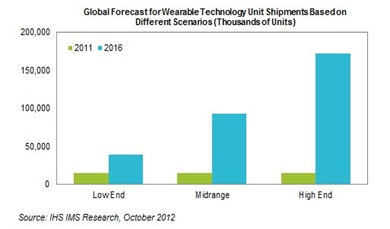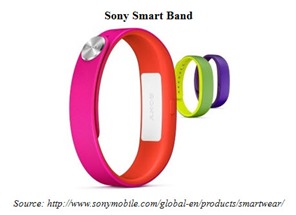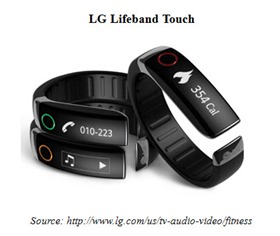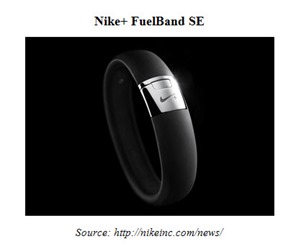Another CES has come and gone and, undeniably, wearable technology, in the form of a variety of smart bands, smart watches and even smart glasses, will be absolutely the major focus of CES 2014. Functionally, wearable technology that doesn’t fall into categories, such as smartphone and smart TV with the emphases of software and hardware innovation, is talking about the applications of our daily lives and consumer markets including healthcare and fitness. Wearable technology, started in 2013, is an exploding product category, which we can find whether IT brands or sports brands have announced as the mainstream consumer products in 2014. According to the report from IMS Research (as shown below), 14 million wearable devices were estimated to have been shipped in 2011 with almost $2 billion in revenue. However, the market size and the share are projected to seem significantly different by 2016, when 171 million devices will be shipped to achieve up to $6 billion in revenue.
The applications of wearable technology, related to wireless transmission Bluetooth®, data processing and detector sensor, have developed to collect, record and manage the data of user’s breathing, heartbeat, pulse, temperature, blood pressure and other physiological responses, sending to his/her smartphone or cloud service afterwards. Thus, Bluetooth® technology especially for Bluetooth 4.0 which is famous for low power consumption and able to run streaming data in the low-energy mode for a long period of time, making Bluetooth 4.0 perfect for wearable technology. To ensure the quality of Bluetooth®, the relevant certification process has become the critical issue. As the BQTF (Bluetooth® Qualification Test Facility) accredited by Bluetooth SIG, Allion is going to provide the vendors with further assistances in conducting certification process, executing interoperability testing, making debugging analysis and providing real-time consultation service.
With the market saturation of smartphone, wearable devices are expected to hit different market without cutting-edge production technology and cost, and to meet the requirement of user experience and user scenario. We can say that CES 2014 could be also called “The wearable technology show” where many IT brands and sports brands including Sony, LG, Nike and Adidas have launched their own wearable devices.
The Smart Band, launched by Sony Mobile, comes in rubber material with the core to connect with the smartphone and tablet PC apps via Bluetooth® technology. The follows of Smart Band could be the life-tracking of heart rate, pedometer and even for marathon. As shown above, Smart Band incorporates with a removable core which is capable of tracking your motion anywhere. Because Smart Band has no built-in display screen, the control and the interaction of smartphone becomes extremely important when users receive calls, messages and listen to the music.
LG’s Lifeband Touch is also a fitness tracker with built-in OLED touch screen by using Bluetooth® to connect with smartphone to keep track of time, heart rate and related fitness records. Like Sony’s Smart Band, Lifeband Touch offers the basic features, including incoming call notifications, music playback and so on. In particular, LG’s innovative HRM (Heart Rate Monitor) earphones are not only for listening, but also feature PerformTek sensor technology which can more accurate measure blood flow signals, metabolic rate and maximum oxygen consumption (VO2 max) rate.
Because wearable technology is on the verge of becoming a multi-billion dollar industry; in addition to the IT industry, the global sports brands such as Nike and Adidas also announce the debuts of their own wearable devices. Overall, their market and functional positioning is more oriented toward fitness monitoring system, focusing simply on daily activity tracking and training strategy for the active runner who wants to track and record specific workouts. It’s worth noting that the future intelligent clothing called “Smart Textiles” will be embedded digital components with small computers or detector sensors to track more precise physiological coverage of the whole body; meanwhile, user can completely control the real-time physiological and physical activities.
Wearable technology is going to be a buzzword into the market inevitably. Allion has been keeping up with the times and showed concerns about the trend and development of smart watch (please refer to our competitive analysis test report, “New Friend on Wrist: Smart Watch Test Report”). Our insight is that the certification and validation processes of wearable technology are very essential to ensure its software and hardware integration and interoperability. Different from the past user scenario of IT industry, the vendors have to consider how to integrate the user experience with wearable device so that wearable technology could be a Cyborg with both organic and mechanical parts of human beings.





































